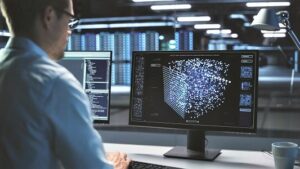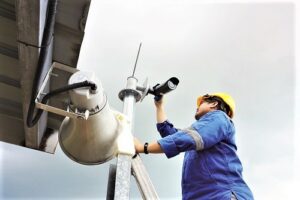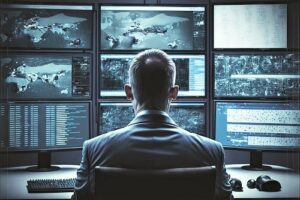Artificial Intelligence comes in many forms: it could be any synthetic being, from a robotic humanoid inside a warehouse to a virtual travel chatbot booking agent. The security industry, in particular, has seen an influx of innovation due to artificial intelligence. Video surveillance for commercial usage is critical for worker safety in workplaces like warehouses, municipalities, inside sporting stadiums, and elsewhere. AI technology is now being deployed to determine if a camera can record an image or if the lens is obstructed. Considering these innovations were not possible a decade ago, this is only the tip of the iceberg.
AI is poised to disrupt the security industry in a big way via one of the most ubiquitous aspects: video monitoring of spaces. In 2023, the video surveillance industry is anticipated to be worth roughly $62.6 billion.
Systems integrators should make sure that all the funds going toward video surveillance cameras are not wasted away with ineffective technology. Even the highest-resolution camera can suffer from a scratched lens or an interfering insect, rendering it useless.
Therefore, companies are using AI software to maximize the efficiency of surveillance devices by observing if the cameras are recording the evidence they expect to have without any faults or disruptions. The AI can determine if the image is too blurry, if the lens is smudged, or if the entire device is tilted. AI for video surveillance will continue to beneficially disrupt the security industry, leading to safer and more efficient tasks and resulting in a tremendous amount of trust that the image will be there when needed.
Improving Pattern Recognition
Every year, improvements are made to AI algorithms. These computer programs are presented with, in this case, images containing examples of target concepts such as “blurry image” or “blue car.” The AI picks out statistical patterns in the images representing those target concepts.
Each year, AI’s ability improves in its ability to cue in on true patterns and filter out spurious or random variations that sometimes are part of the target concept, such as reflections, shadows or obstructing objects. We use AI based on patterns and predictions because there is too much data to sift through, and it is too complex for people to do so manually.

Every year, improvements are made to AI algorithms. Image: gorodenkoff/stock.adobe.com.
Another important contributing factor is the computing hardware used for artificial intelligence. Algorithms are instructions, much like a recipe, before a chef cooks a meal. AI is an algorithm that writes its own rules from example images provided by the user in a process called “training.” The AI can then use those rules on new data it has not seen before, to automatically do the given task.
The hardware used to execute the rules of an AI algorithm has advanced significantly, too, in terms of more computations per second. This new hardware enables AI algorithms to find better and more authentic patterns in ever larger datasets of examples. Developers train AI software to recognize specific objects or individuals, allowing it to filter out irrelevant information and focus on important events.
The more accurate an AI’s functionality is, the more it becomes possible to monitor increasingly larger areas with fewer cameras and personnel, reducing costs and increasing coverage.
Maximizing Safety & Efficiency
It’s crucial to find applications contributing to a location’s safety. Shoppers in a mall, for example, expect protection from security cameras placed throughout the building. People may let their guard down in these secured areas because of the perceived safety.
If the shopper is aware that AI software is installed to augment the capabilities of video surveillance devices, security managers and shoppers will have the assurance that if an incident occurs, such as a thief stealing someone’s purse, the software will confirm that the camera was recording properly at the time of the incident.

The more accurate an AI’s functionality is, the more it becomes possible to monitor increasingly larger areas with fewer cameras and personnel, reducing costs and increasing coverage. Image: mohamad zaki/stock.adobe.com.
AI software will also realign security guards’ and property managers’ expectations. If a security guard has AI software monitoring their surveillance devices, it can simplify their job duties in several ways.
AI software can automatically analyze and process large amounts of data from the surveillance cameras in real-time, which means the guard doesn’t have to monitor the live camera feeds manually and continuously. The security managers are enabled through the software to know that each unit is working correctly. This advancement frees the guard’s time to focus on other essential tasks, such as conducting patrols or responding to alarms.
Better outcomes are the result of better performance, and this sentiment remains true for systems integrators looking to add AI software to their security cameras. Security managers will achieve optimal video surveillance with AI software because this technology maximizes safety and efficiency. As a byproduct, the cost will decrease, making effective and efficient video surveillance equipped with AI software more prevalent across industries.
Advancing Capabilities = Trust
One of the critical advantages of AI-powered video surveillance devices is their ability to analyze and process large amounts of data in real-time. These advantages enable the system to quickly detect and respond to potential security threats, such as suspicious behavior or intrusions. Additionally, developers train AI software to recognize specific objects or individuals, allowing it to filter out irrelevant information and focus on important events.
People can observe the compounding growth rate of AI capabilities in object recognition technology, which shows how the improvements in AI capabilities over the past few years led to a more accurate and trustworthy system. The sheer fact that there is an increasing number of users deploying video surveillance equipped with AI software strongly indicates the benefit in real-world use cases. If they didn’t have confidence in it, they wouldn’t use it.

The ability of AI to improve pattern recognition will allow security systems to detect and respond to potential threats more quickly and accurately. Image: alfazet chronicles/stock.adobe.com.
AI for camera security will become more commonplace as more people begin to trust it, much like airbags within cars have become ubiquitous. Today, people and organizations purchase security cameras with or without AI software. However, no one buys an SUV without airbags. Frankly, it’s not an option anymore. In the coming years, video surveillance without AI software to monitor the correctness and clarity of the camera views will be obsolete.
It is irresponsible, and now mostly illegal, for a car dealer to sell a motor vehicle without airbags to a customer. Likewise, it may soon become unacceptable for systems integrators to sell security managers a shipment of security cameras without such similar protection. The protection in this case being AI software that monitors the operational correctness of the cameras, including the correctness of the view that the camera is streaming and that the camera system is truly recording video as evidence.
Harnessing the Power
The ability of AI to improve pattern recognition will allow security systems to detect and respond to potential threats more quickly and accurately. AI software for video surveillance will maximize safety and efficiency, leading to more trust among systems integrators. AI-powered security systems will be able to process large amounts of data in real-time and to automatically respond to potential threats, significantly improving the system’s overall security.
To fully realize the benefits of AI in the security industry, companies need to invest in developing and implementing AI technology. Using AI to its fullest includes investing in research and development, training employees, and working with AI experts to implement the technology to maximize its potential.
By taking action now, companies can take full advantage of AI’s benefits in the security industry.
Dr. Daniël Reichman is CEO and Chief Scientist of Ai-RGUS, an AI startup spun out of Duke University.
The post Keeping an Eye on AI appeared first on Security Sales & Integration.
